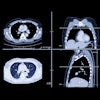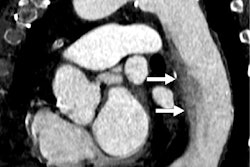Ultrahigh-resolution CT angiography (CTA) bests conventional CTA for the detection of ruptured intracranial aneurysms, offering higher sensitivity, improved image quality, and reduced radiation dose, according to a study published October 9 in Academic Radiology.
The findings could translate into better patient care, wrote a team led by Marius Frenzel of Johannes Gutenberg University, in Mainz, Germany.
"The 'time is brain' paradigm emphasizes the importance of timely and accurate diagnostics in the case of hemorrhagic stroke," the group noted. "If a ruptured aneurysm is missed in primary CTA imaging and diagnosed later on additional CTA or DSA [digital subtraction angiography] imaging, the resulting treatment delay may increase the risk of aneurysm re-rupture."
Ruptured intracranial aneurysms are the main cause of atraumatic subarachnoid hemorrhages, and can cause life-threatening complications, the team wrote. Identifying them quickly on CT imaging is crucial, and using high-resolution CTA can help do this.
The group compared the performance of ultrahigh-resolution CTA (slice thickness down to 0.25 mm and spatial resolution of up to 50 lp/cm) to conventional CTA for detecting and characterizing intracranial aneurysms via a study that included 108 patients with atraumatic subarachnoid hemorrhage who underwent digital subtraction angiography (DSA) and either ultrahigh-resolution CTA or conventional CTA.
Three readers evaluated the image quality, diagnostic confidence, and ability to identify intracranial aneurysms on the two forms of CTA, and the researchers calculated sensitivity and specificity and compared effective radiation dose. DSA served as the reference standard.
The team found that ultrahigh-resolution CTA had higher image quality and diagnostic confidence for all readers – and lower effective radiation dose (p < 0.001).
The group also reported the following:
| Comparison of conventional CTA to ultrahigh-resolution CTA for identifying aneurysm |
||
|---|---|---|
| Measures |
Conventional CTA |
Ultrahigh-resolution CTA |
| Mean effective dose per patient |
189 mSv |
136 mSv |
| Correct classification of aneurysm |
84% |
98% |
| Sensitivity (patient level) |
||
| Reader 1 |
82% |
100% |
| Reader 2 |
88% |
100% |
| Reader 3 |
88% |
100% |
| Sensitivity (segment level) |
||
| Reader 1 |
76% |
96% |
| Reader 2 |
82% |
96% |
| Reader 3 |
82% |
98% |
Specificity was comparable between the two techniques, Frenzel and colleagues wrote. They also noted that both CT dose index-volume and dose length product (and therefore, estimated effective dose) were lower on ultrahigh-resolution CTA compared to conventional CTA (p ≤ 0.001).
"The improved sensitivity [of ultrahigh-resolution CTA] may be especially reassuring for out-of-hours settings where fewer experienced observers tend to be present," the team wrote. "This may additionally decrease the need for further diagnostic imaging, further reducing radiation exposure and accelerating critical treatment pathways."
The complete study can be found here.




















